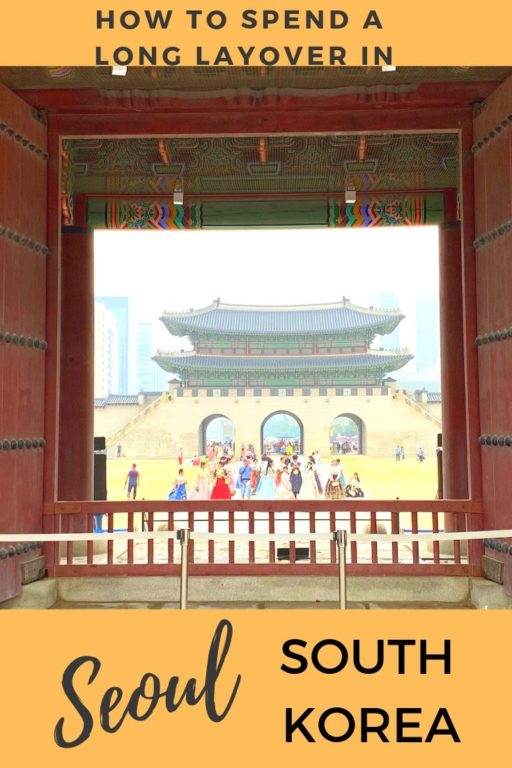Sometimes, one of the best perks about traveling on international airlines are the long layovers. While some people prefer direct flights, I’ve usually tried to break up long flights by having free extended layovers. I have always wanted to visit Seoul, South Korea so we jumped at the opportunity to visit even if it was only for a short time. Here’s what to do on a long layover in Seoul.
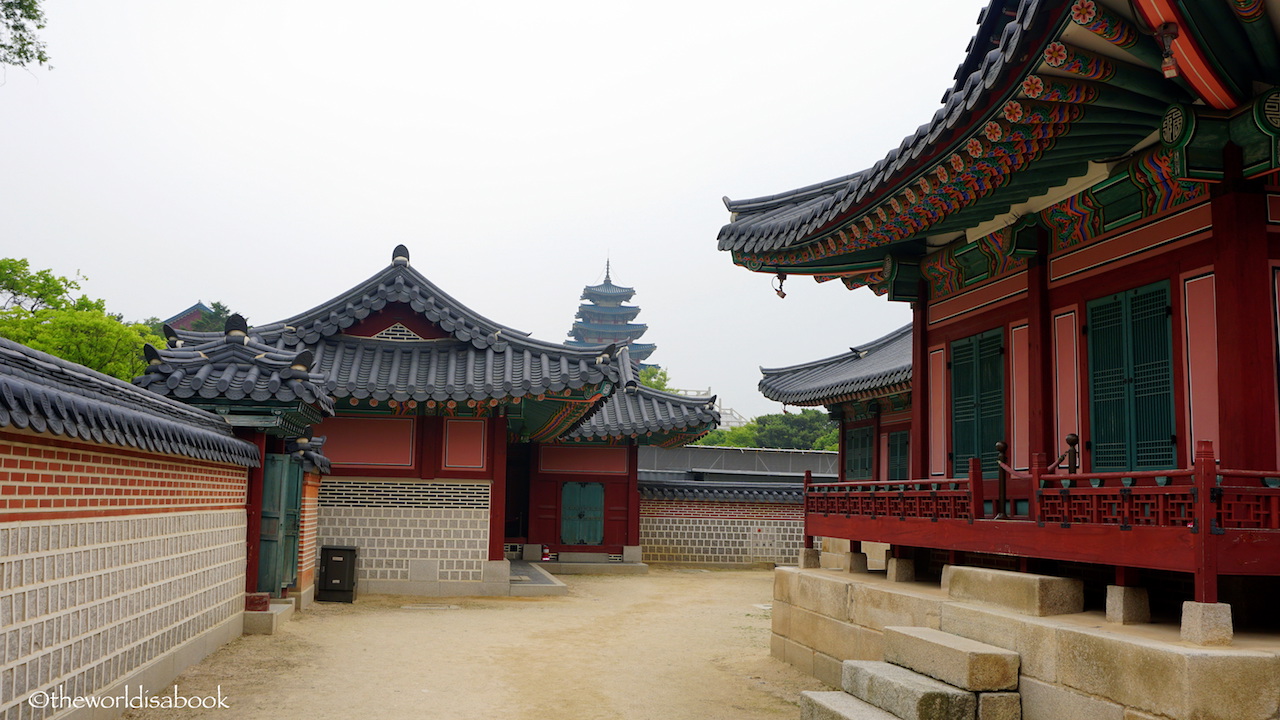
We’ve been lucky to take advantage of these international layovers in Fiji, Iceland, Ecuador, Amsterdam and Tokyo. This was we how we spent two 15-hour layovers in Seoul via Asiana Airlines on our way to Hanoi, Vietnam. It was well worth it.
We stayed at a nearby hotel in the town of Incheon to sleep. It’s hard to sleep well in airplanes even if it was a 13 hour flight from Los Angeles. We took a 3-hour power nap at an airport hotel and were well rested and ready to explore afterwards. Luckily, there was a train station less than a 5-minute walk away that took us directly into Seoul.
Visit Gyeongbokgung Palace
Our first stop was the Gyeongbokgung Palace. This was supposedly the most visited attraction in Seoul. Its name means “palace greatly blessed by Heaven”.
This once royal residence was rebuilt and restored in 1867 after most of its buildings were destroyed during the Japanese occupation. It still looked very impressive and there were many structures within the complex.
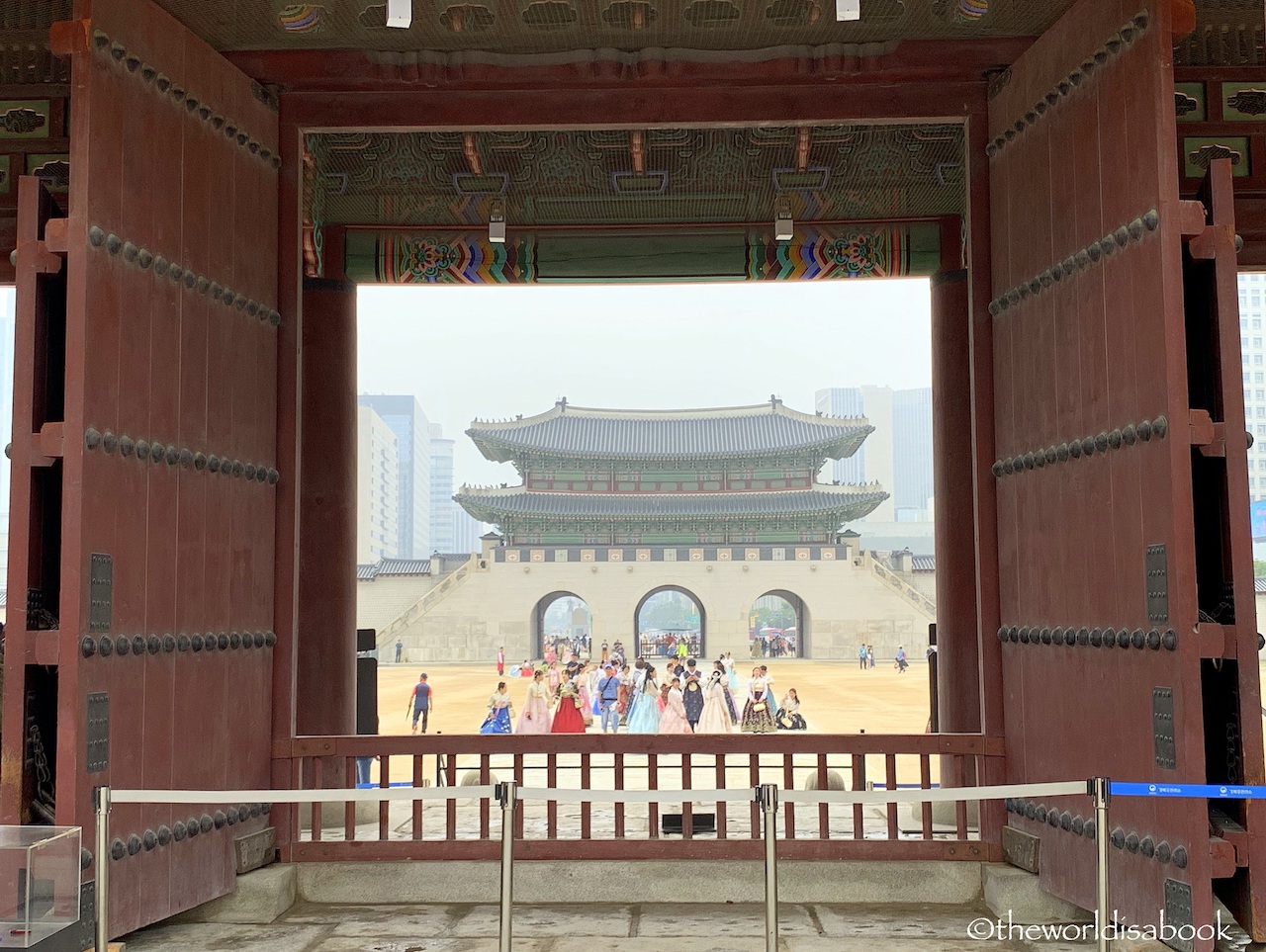
Changing of the Guards
We made it in time to watch the procession and changing of the guards by the Gwanghwamun gate. This was a reenactment of the ceremony that once took place when the guards changed shifts. The royal guards once protected the capital city, the king and palaces during the Joseon Dynasty.
The reenactment, based on historical records, showed the guards’ uniforms, accessories, and traditional weapons they would have carried. The ceremony started with a very loud drum and there were also other instruments played. It was very interesting and colorful with so much pageantry.
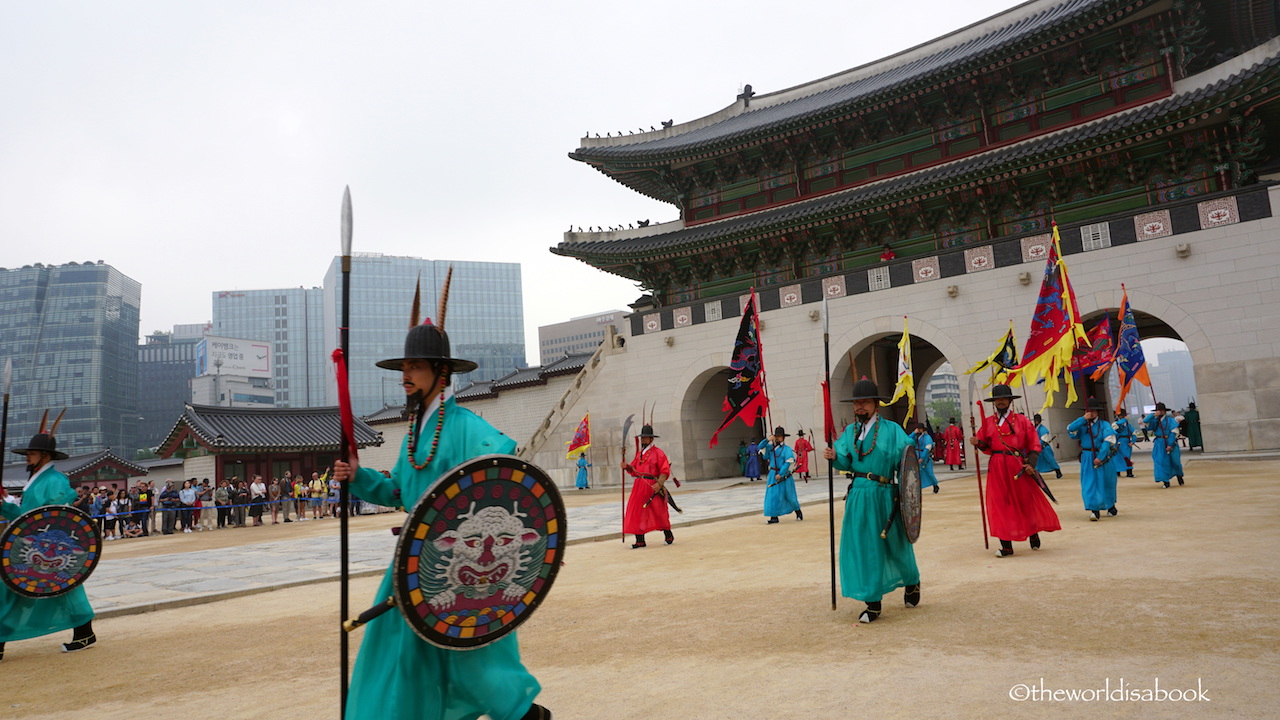
Go towards the front by any of the ropes to get a great view of the whole ceremony. It was actually easier to see this ceremony compared to similar ones like Buckingham Palace because there was so much open space.
Don’t miss this! The royal guards were so close and we could see the details of their uniforms and weapons. The Changing of the Guard ceremony takes place a 10 AM and 2 PM everyday except Tuesday. It lasted about 20 minutes.
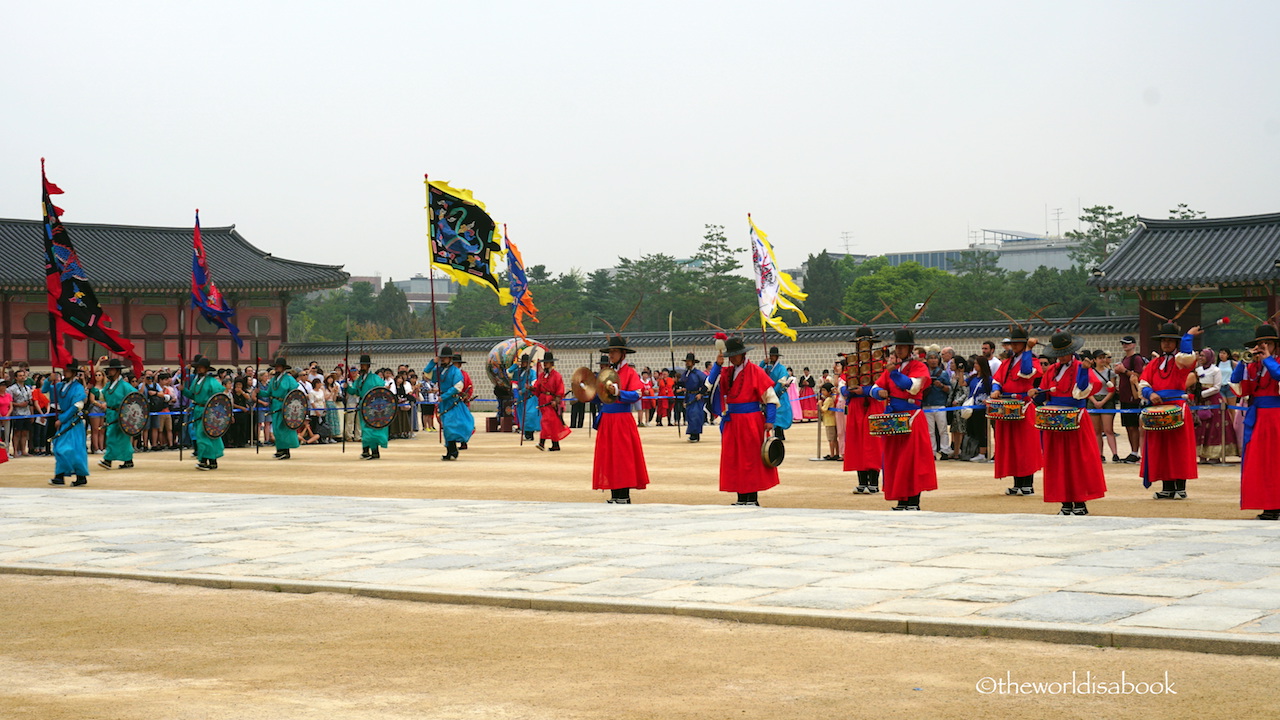
Other Cultural Attractions and Activities
There were also other performances to see here. This included the Gwanghwamun gate guard-on-duty performance at 11 AM and 1 PM which is only 10 minutes. There was also the Gatekeeper Military Training outside the Hyeopsaengmun Gate at 9:35 AM and 1:35 PM that last 15 minutes.
Visitors can also participate in the Sumungun Costume Experience. Go to the Sumunjangcheong Building (located to the left of main gate entrance) before and after the Guard Changing Ceremony and the Guard-On-Duty Performance to try on the guard costumes for free.
It is on a first come, first serve basis to try on the costumes and photo ops for about 5 minutes. My teens didn’t really want to do it.
It was a pleasant surprise to see so many visitors (men, women and children) wearing the hanbok or Korean traditional clothing. I love how colorful they were.
Visitors can rent them from several shops outside the palace. Admission is free if you go into the palace wearing a hanbok.
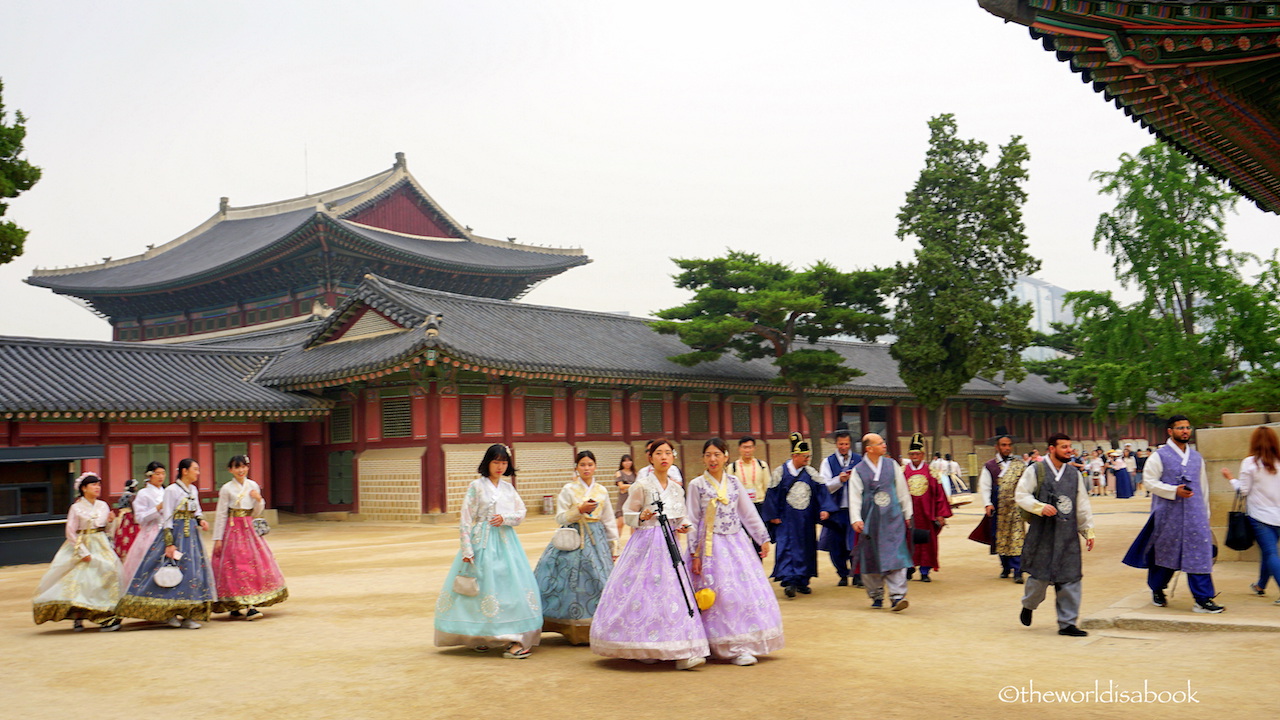
Visit the Geunjeongjeon Hall
It was hard to miss the large Geunjeongjeon Hall which was the palace’s main throne hall. This hall was reconstructed in 1867 after the original was burnt down during the Japanese occupation in the late 1500s. This was where celebrations and coronations were mostly held along with receptions for foreign visitors.
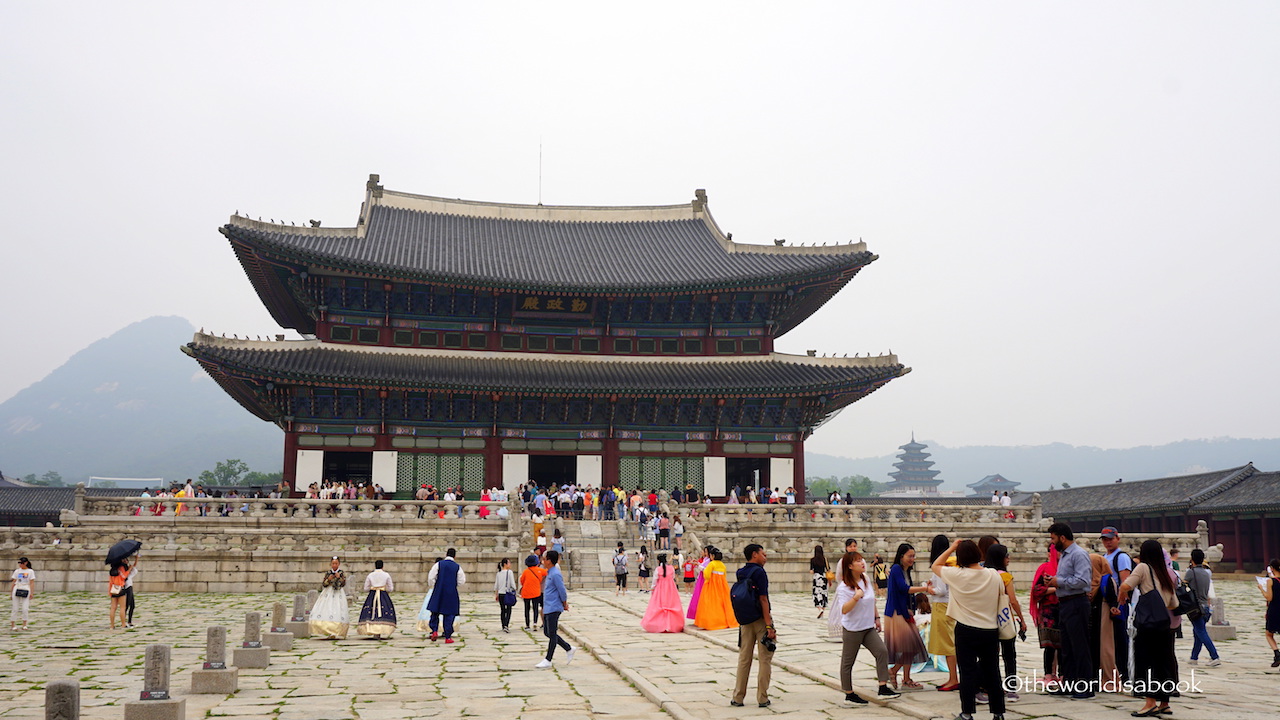
We couldn’t go inside the hall but it was wide open to see the colorful and ornate details. I loved the intricate decorations on the ceiling. The king’s throne was still there and you can almost imagine all the fancy ceremonies that occurred here.
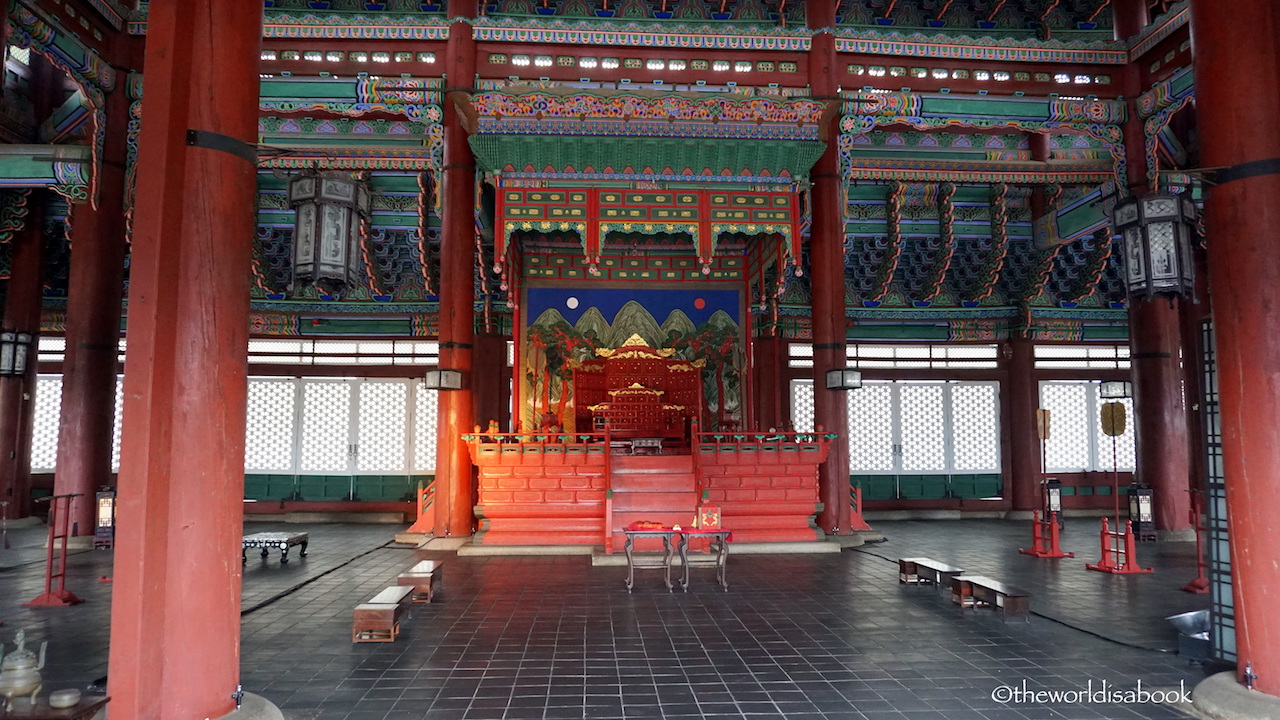
Gyeonghoeru Pavilion
My favorite area was the Gyeonghoeru Pavilion which was surrounded by a tranquil, manmade pond. The royals used the pond for boating during the summer. This current structure was built in 1867 after the original two-story pavilion burnt down.
Officials use this pavilion to entertain foreign visitors. There were several benches around the pond to enjoy the pavilion and the mountain views behind it.
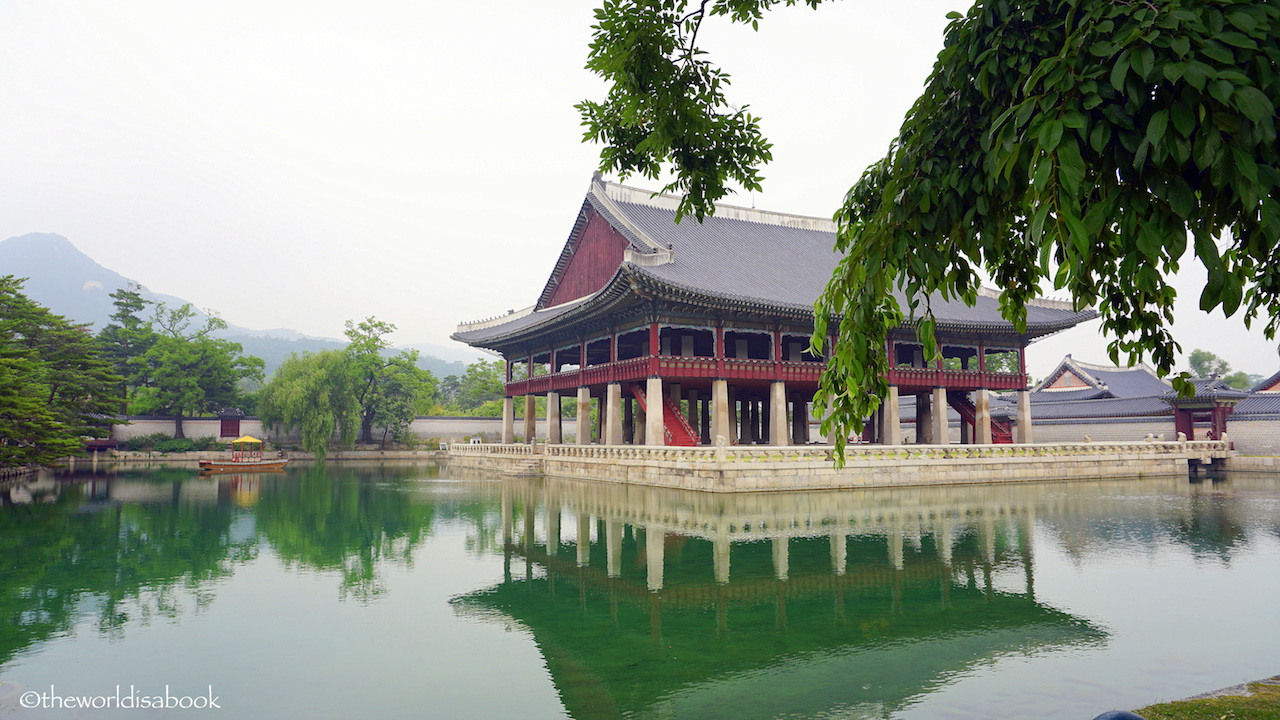
The National Folk Museum
The National Folk Museum of Korea was within the Gyeongbokgung Palace and was free to enter. We only planned a short walk through the museum but ended up here for almost an hour. We learned a lot from visiting this unique museum.
There were three permanent exhibits in the museum. They were the culture and history of the Korean people which showed their daily lives.
The Korean way of life exhibit showed how the farmers worked and adapted with an insight into their daily lives. The Life Cycle of Koreans exhibit was a contrast since it showed how the upper class citizens lived.
They were all very well laid out exhibits with many historical artifacts and interesting items. I loved the food and clothing displays. There were even house replicas inside the museum to really understand how the Koreans lived.
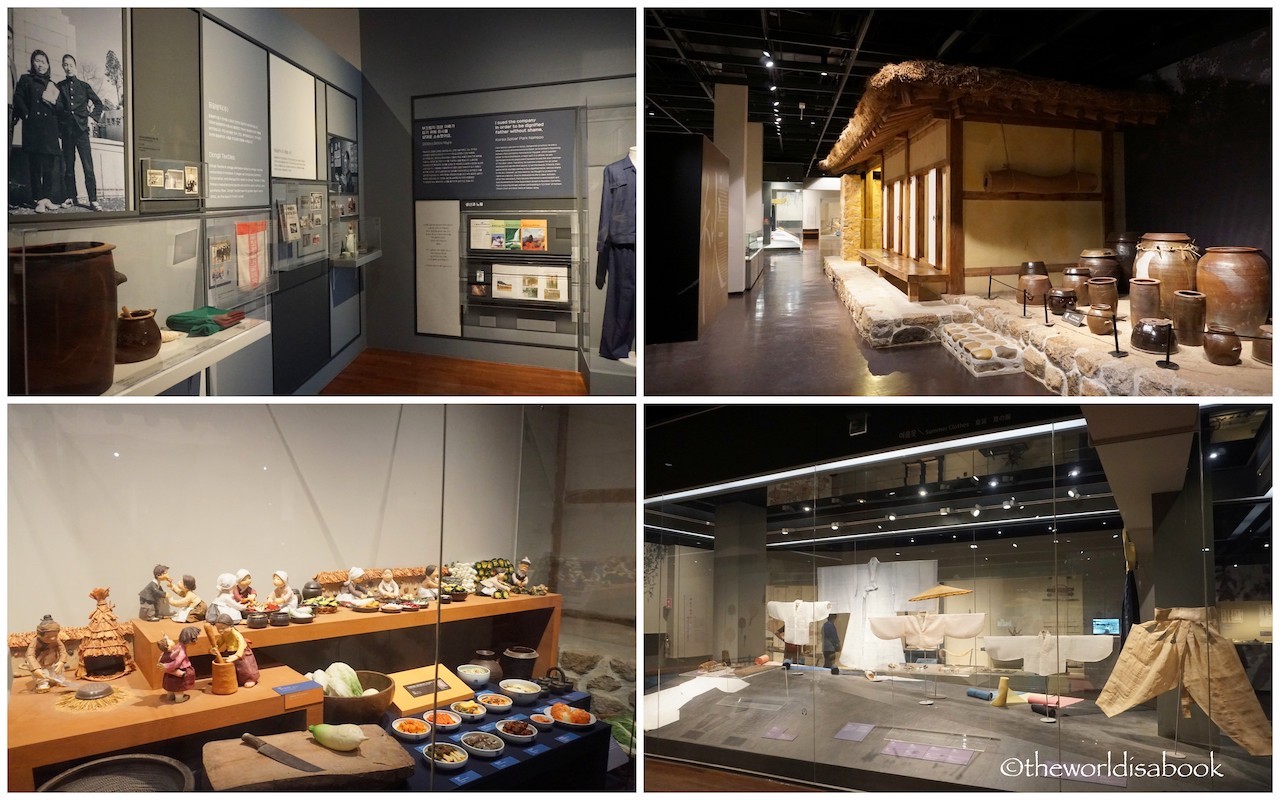
There was also a children’s museum but we didn’t get to check it out. We really enjoyed walking around the open-air exhibition outside the most. It was a wonderful area to see the unique exhibits.
The late 19th century traditional village replica was a fun place to stroll. We felt like we were transported through a time portal. It was wonderful to see the various stores and even a peek into a school classroom.
We also liked walking through a couple of houses and seeing a grinding mill. There was even a totem pole here and several stone statues of military looking people. The museum is closed on Tuesdays. They offer free guided museum tours at 10:30 AM and 2:30 PM for a more in-depth look.
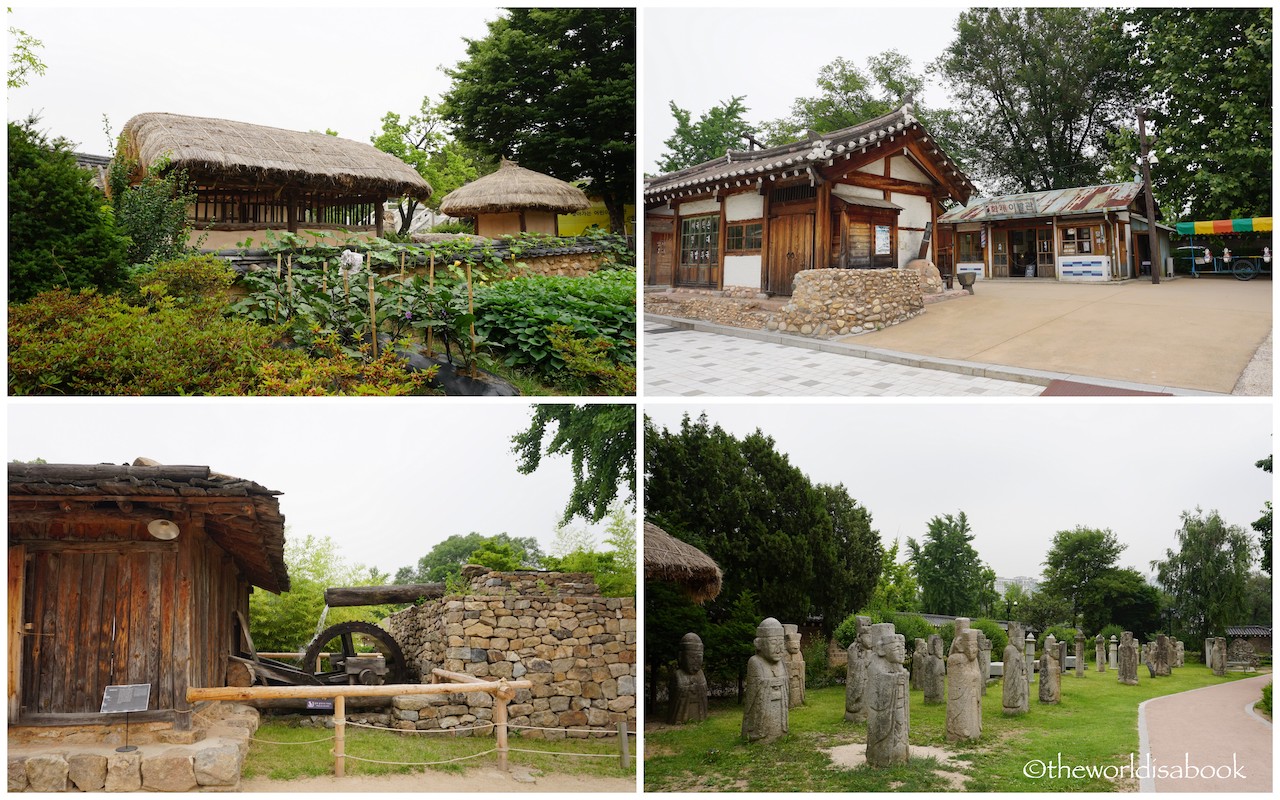
Explore Bukchon Hanok Village
Bukchon Hanok Village is a charming neighborhood surrounded by a couple of palaces and a short walk from the Gyeongbokgung Palace. The village has hundreds of traditional houses with long curved roofs (called hanok) with about 600 years of history. Bukchon translates to “northern village”.
High-ranking officials and their families once occupied these hanoks since they were located near the palaces. As urbanization progressed in Seoul and with changes in society, commoners moved into these hanoks and this neighborhood.
Unfortunately, some of these hanoks were also torn down along the way and were replaced by modern and high-rise buildings. There are only about 900 of these hanoks left in the neighborhood. Now, these renovated hanoks house cultural centers, guesthouses, restaurants, galleries, shops and teahouses.
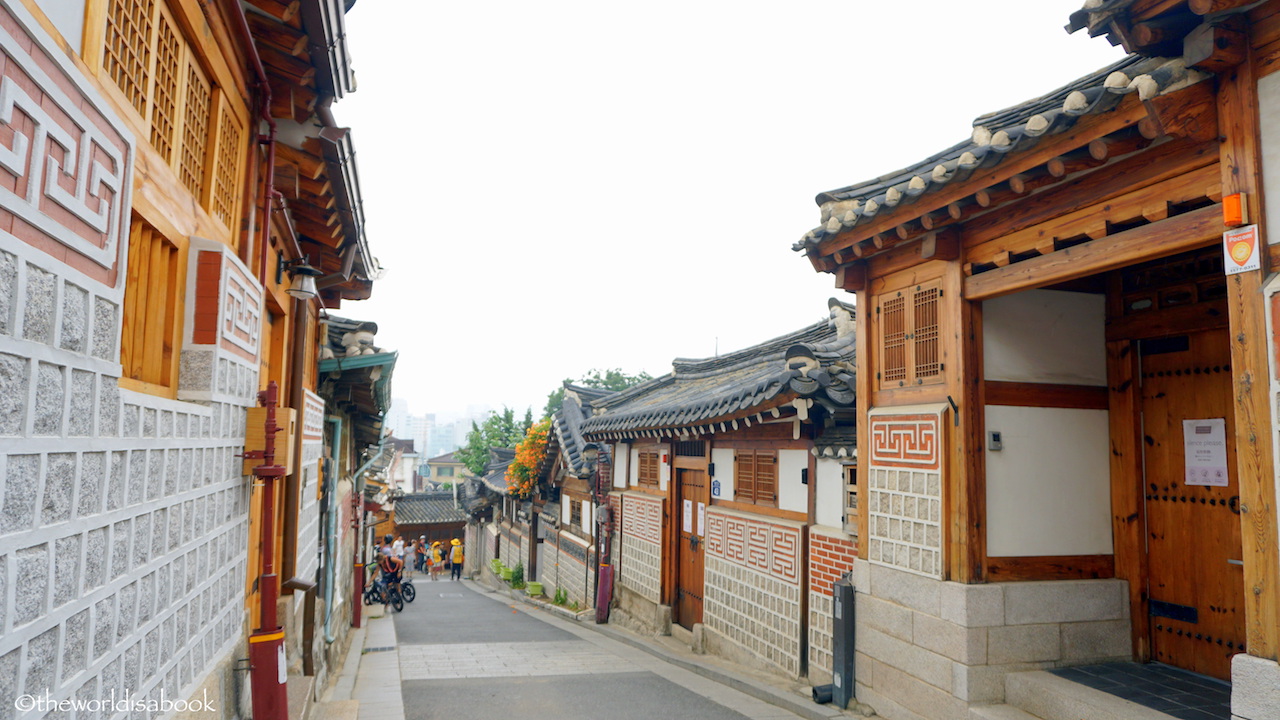
Though, some of the hanoks today are still occupied by actual residents. We found many signs telling visitors to talk softly around the neighborhood or not to trespass to respect their privacy and properties.
There were also some cultural museums and artisan workshops (embroidery, drawing, etc.) that showcase the area’s history. Visiting Bukchon Hanok village was a great way to see and experience traditional Korean culture and see how some part of the city’s residents live.
Several young Koreans, who were like tourist ambassadors, were at designated spots in the neighborhood with maps. They spoke great English and were very helpful.
We loved walking around this quaint village and exploring the shops and its small alleys. Walk all the way to the top for some great views.
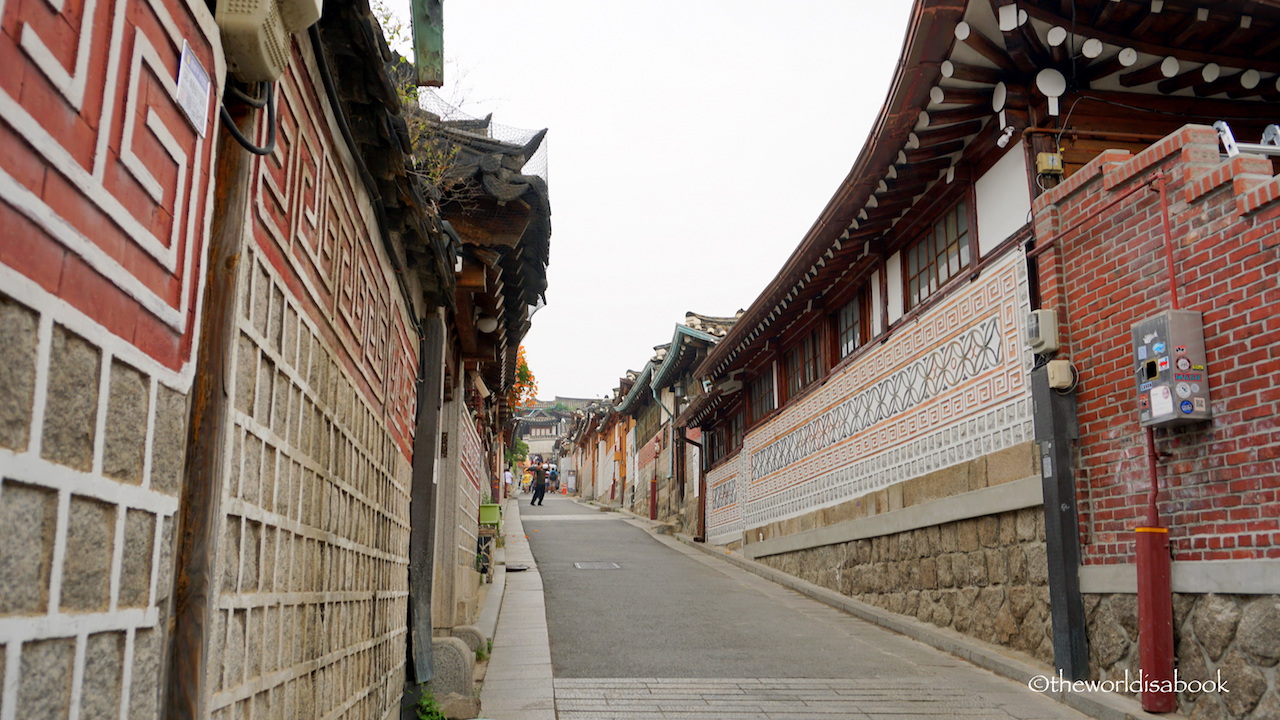
Visit the Insadong Neighborhood
One of the activities we were really looking forward to doing in Seoul was shopping. Insadong was the ideal place to go if you are near the palace and the Bukchon Hanok Village area. The Insadong district’s main street was about 700 meters from Tagpol (Pagoda) Park.
It was so lively and filled with many unique shops. There are many various street food vendors during the weekends here. Most of the streets and alleys become pedestrianized and are closed off to vehicles.
Some favorite things to buy in the Insadong area were souvenirs, crafts, ceramics, character socks, cosmetics (especially facemasks) and K-pop merchandise. We loved strolling the streets and exploring the narrow alleys here.
My kids favorite food stall was the Honey Sweet Dragon Beard. There were two neighboring stalls selling similar “Dragon’s Beard Candy”. The young men here were very entertaining.
It was amazing to see them turn thousands of strings of honey into a square wrapped candy filled with almond, chocolate or peanut. It tasted better when eaten cold.
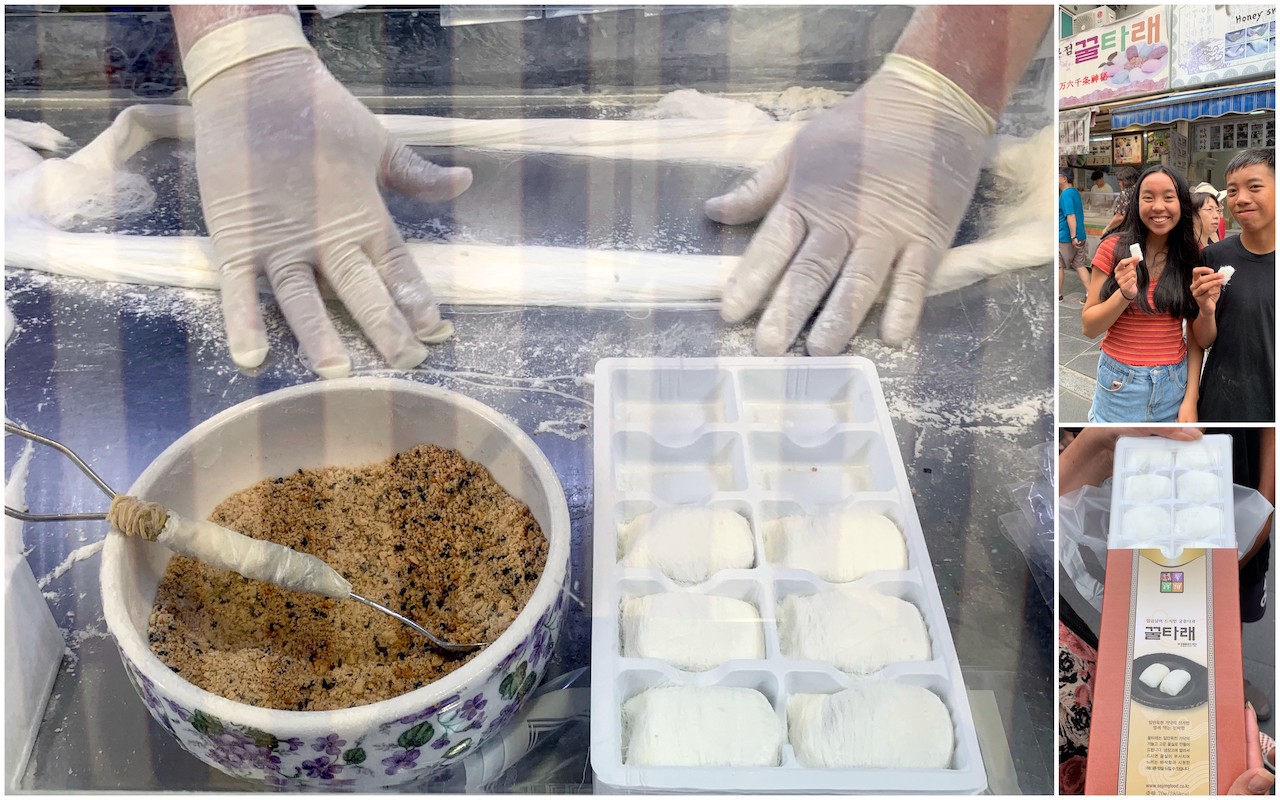
Check out the Poop Café
One of the most interesting eateries that showed up during our research was the DDong Cafe also known as the Poop Café. Yes, poop as in feces. Of course, my teens wanted to check it out. It was located on the top story of the Ssamzigil mall.
The graphic menu stopped us even before we entered the store. This café was certainly creative.
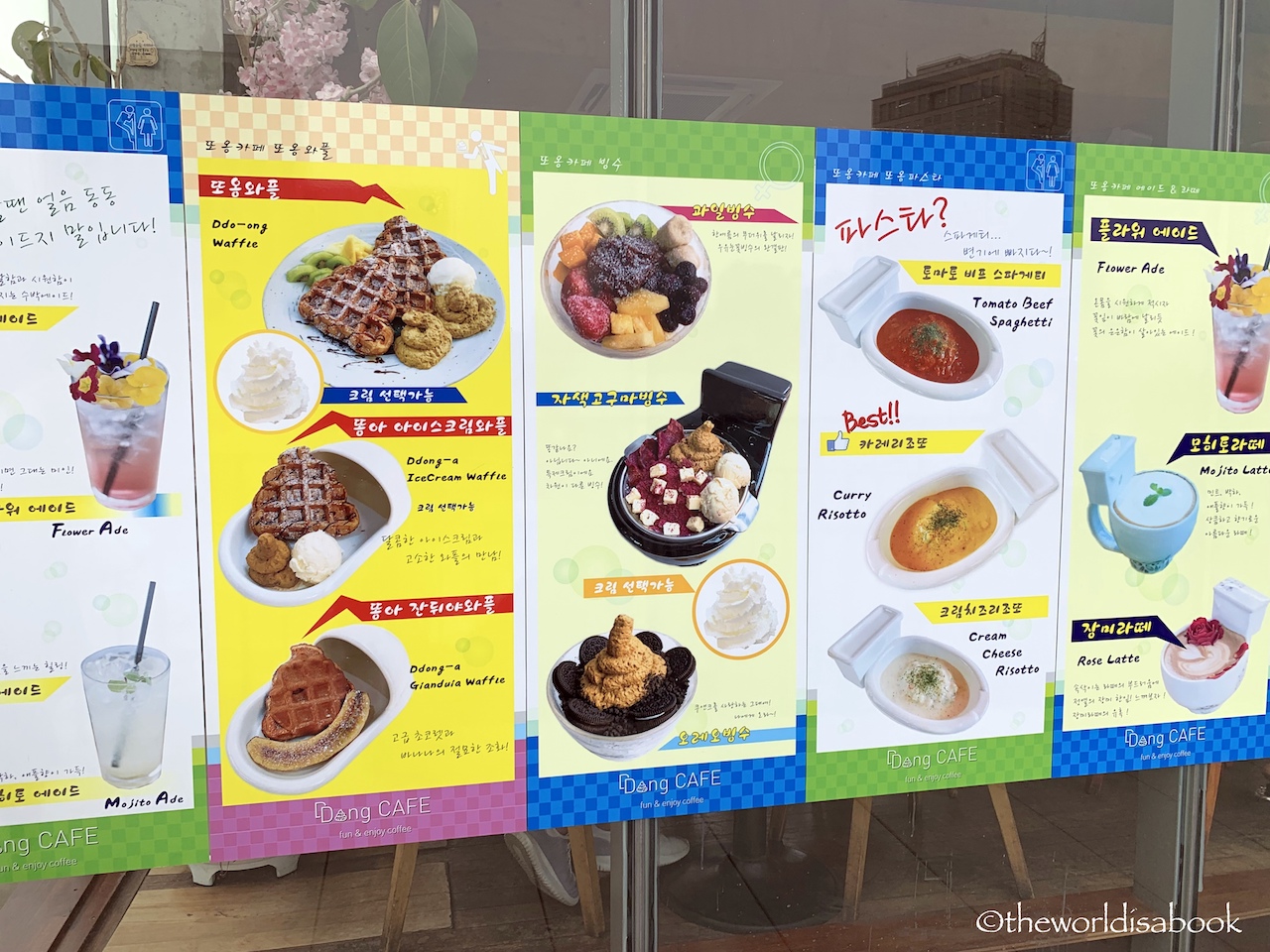
It looked a bit ordinary when we first entered until we saw the details and poop items scattered around. There were squat toilets used as pots for plants, poop type pillows and other interesting décor.
We ordered the Rose Latte and it came out in a toilet bowl cup. We can now say we’ve all drank from a toilet bowl.
The kids also ordered the poop shaped waffle and ice cream that came with a brown cream that looked too realistic. They were definitely Instagram and Snapchat worthy for my teens. If you’re in the area, it was a unique and quirky place to check out, refresh and rest tired sightseeing feet.
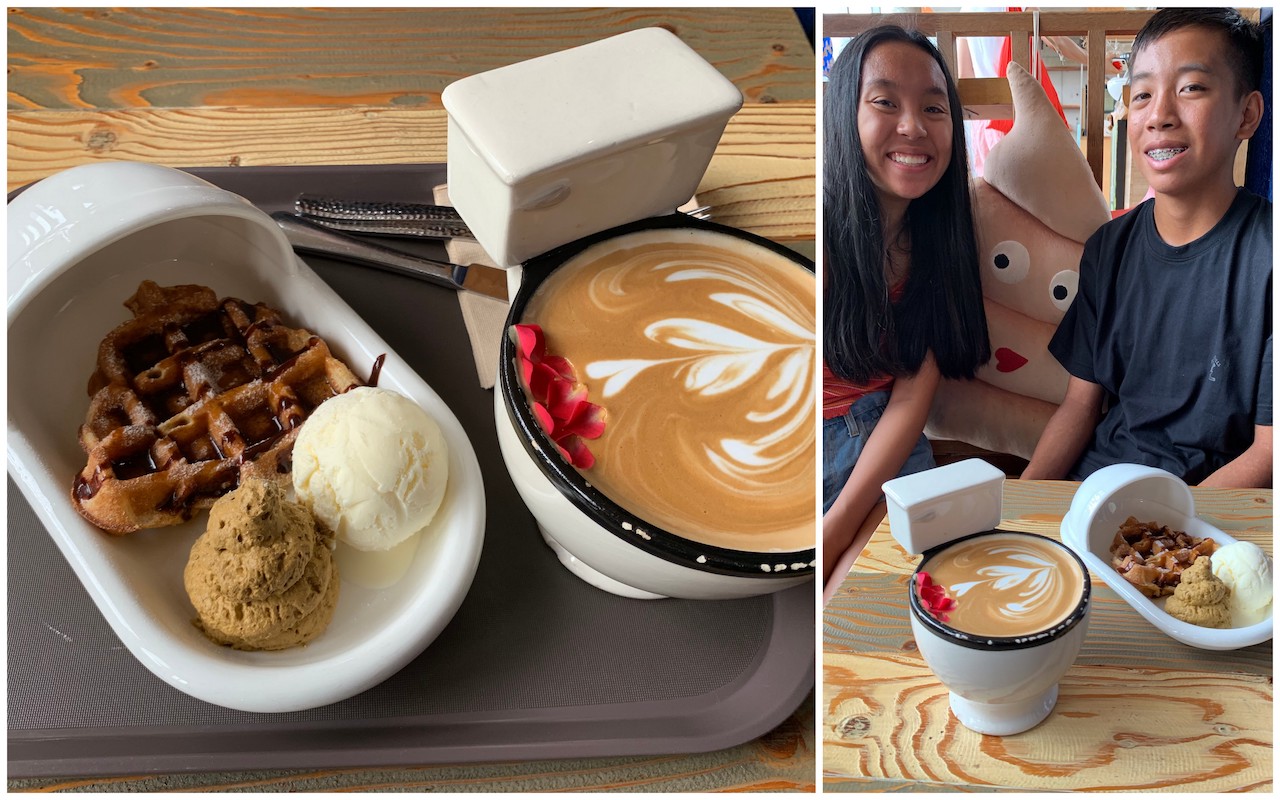
Stop at Gwangjang Market
During our second 15-hour layover on the way home, we wanted to minimize the sightseeing. We just wanted to relax a bit and do more eating and shopping.
Our first stop was the Gwangjang Market. We have visited several food markets all over the world. But, nothing quite compared to this market. This was HUGE!
It was a maze of food stalls surrounded by many shops. It smelled so good walking around here.
Many of the small stalls had seats around it. Come here on an empty stomach and spend a few hours sampling many of the food stalls.
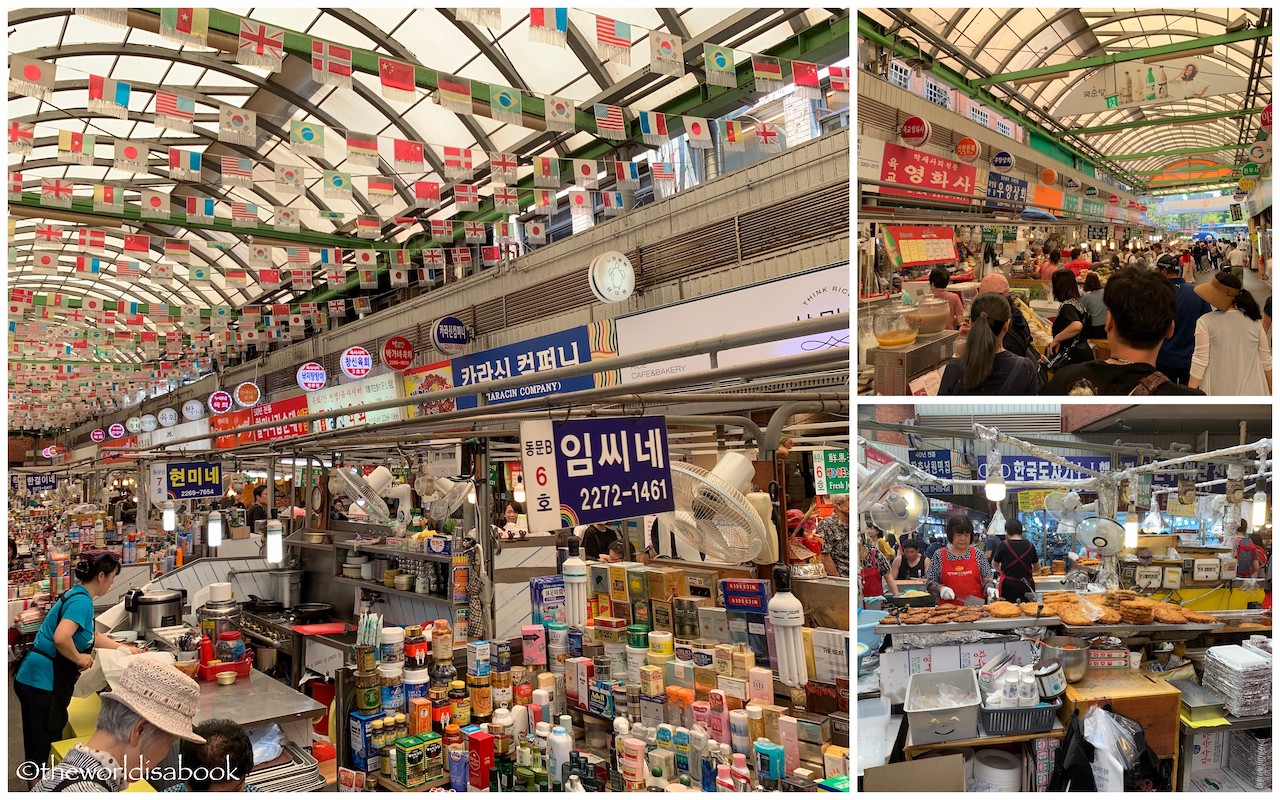
But, our main purpose for visiting the market was to see a sweet woman. We regularly watch Netflix and especially its shows related to food. One of those shows was Street Food Asia.
We were touched by the personal story of Cho Yonsoon who had a food stall here serving kalguksu (Korean knife cut noodles). Her stall wasn’t very big and didn’t have that many seating areas. Not surprisingly, most of the people around her seemed to be Americans who saw the Netflix show and were posing with her.
Luckily, we ended up right in front of her and were able to watch her work cutting the noodles and making her dishes. The menu was limited with only the noodles and either kimchee or pork dumplings.
Despite the summer heat and eating soup, I liked the noodles a lot and the pork dumplings were delicious. My picky eater teens enjoyed the food too.
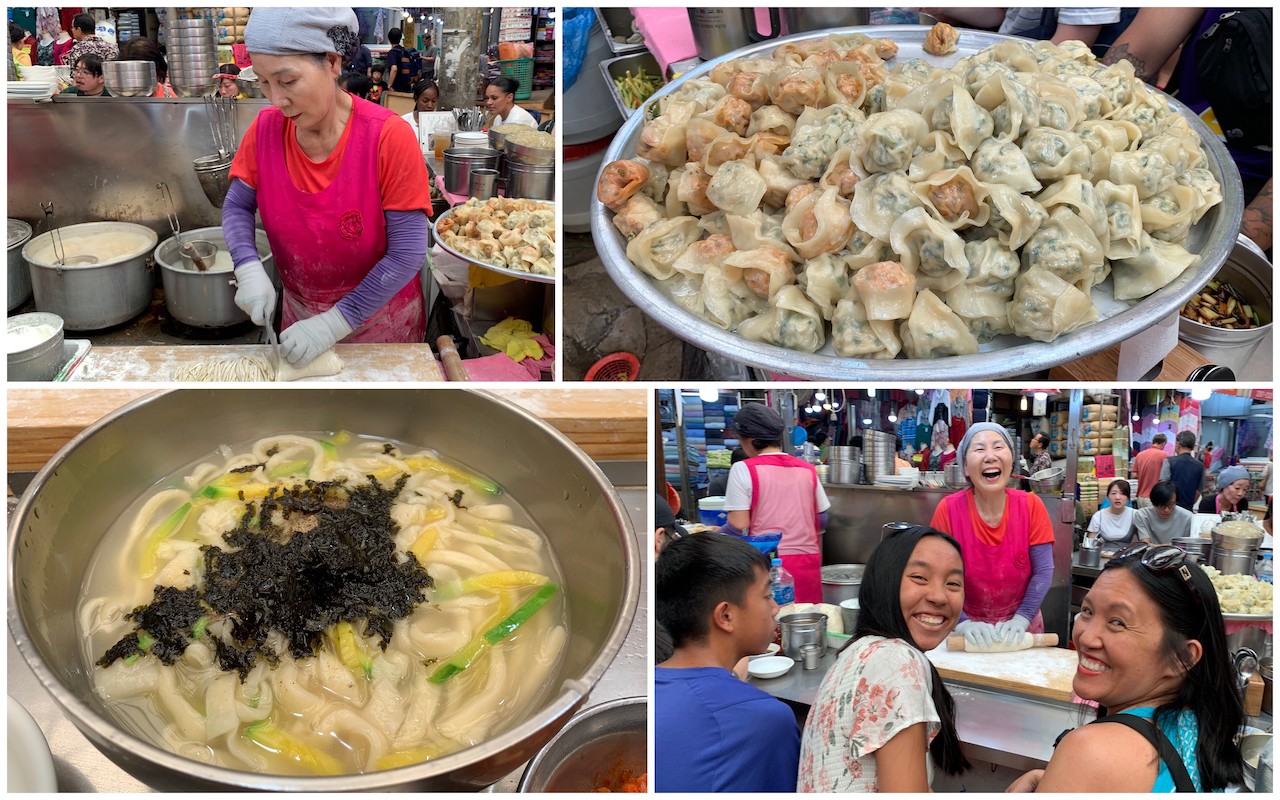
Walk the River
After eating and drinking at the Gwangjang market, we decided to walk to the Myeongdong shopping area that was less than a mile away. The weather was warm. But, it wasn’t too hot or humid compared to Hanoi where we had been just a few days before.
It turned out to be a good idea since we ended up walking along the Cheonggyecheon River. The stream was restored as part of Seoul’s urban renewal project. An elevated highway once covered it.
The stream is about 3.6 miles (11 km) and flows under 22 bridges. There were paved walking paths on both sides of the river with a lot of greenery.
Though, we didn’t see many shaded areas. It was a true urban oasis in the middle of the city.
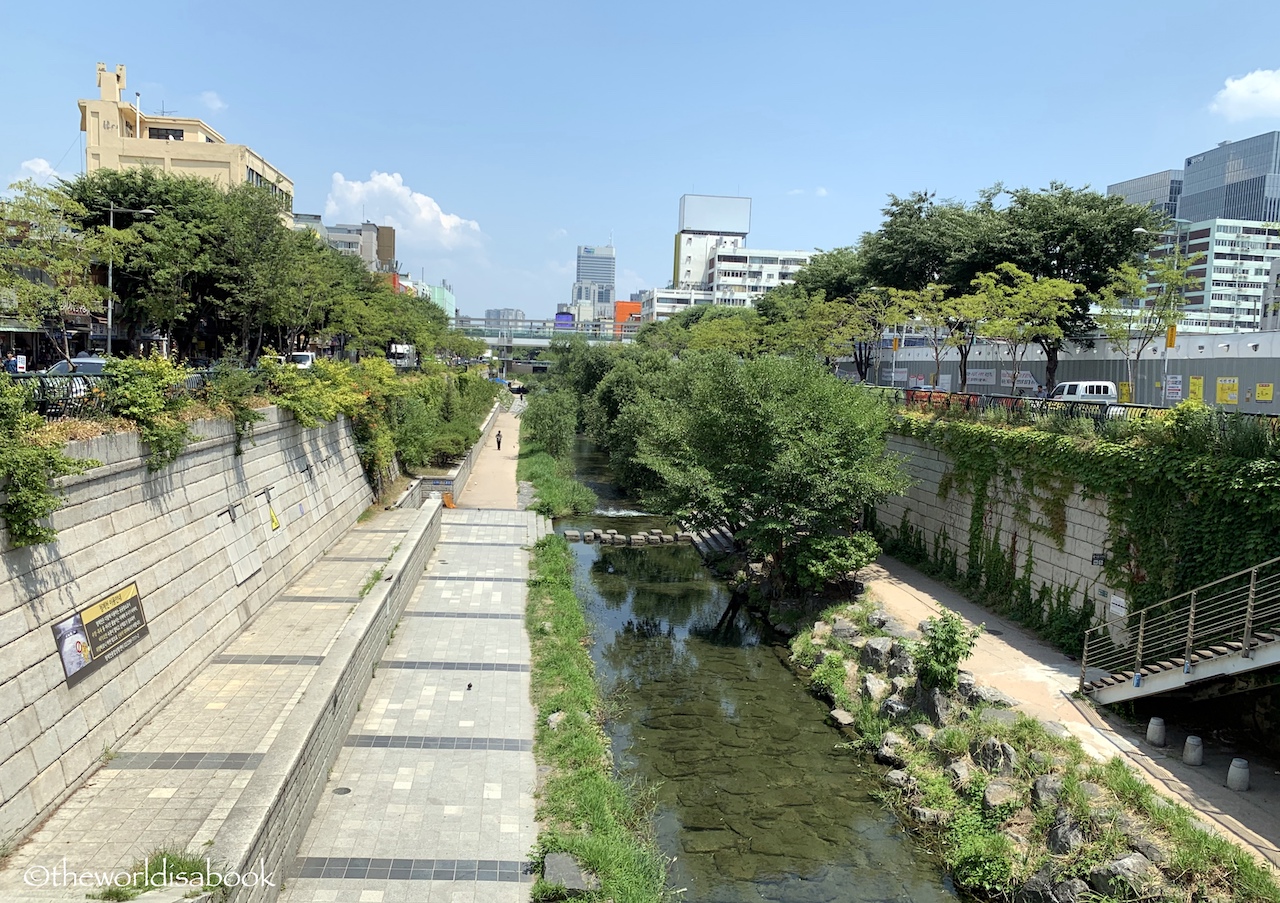
It was a pleasant surprise to find the Myeongdong Cathedral at the edge of the bustling shopping district. The Gothic church sitting on top of a small hill was a beautiful sight.
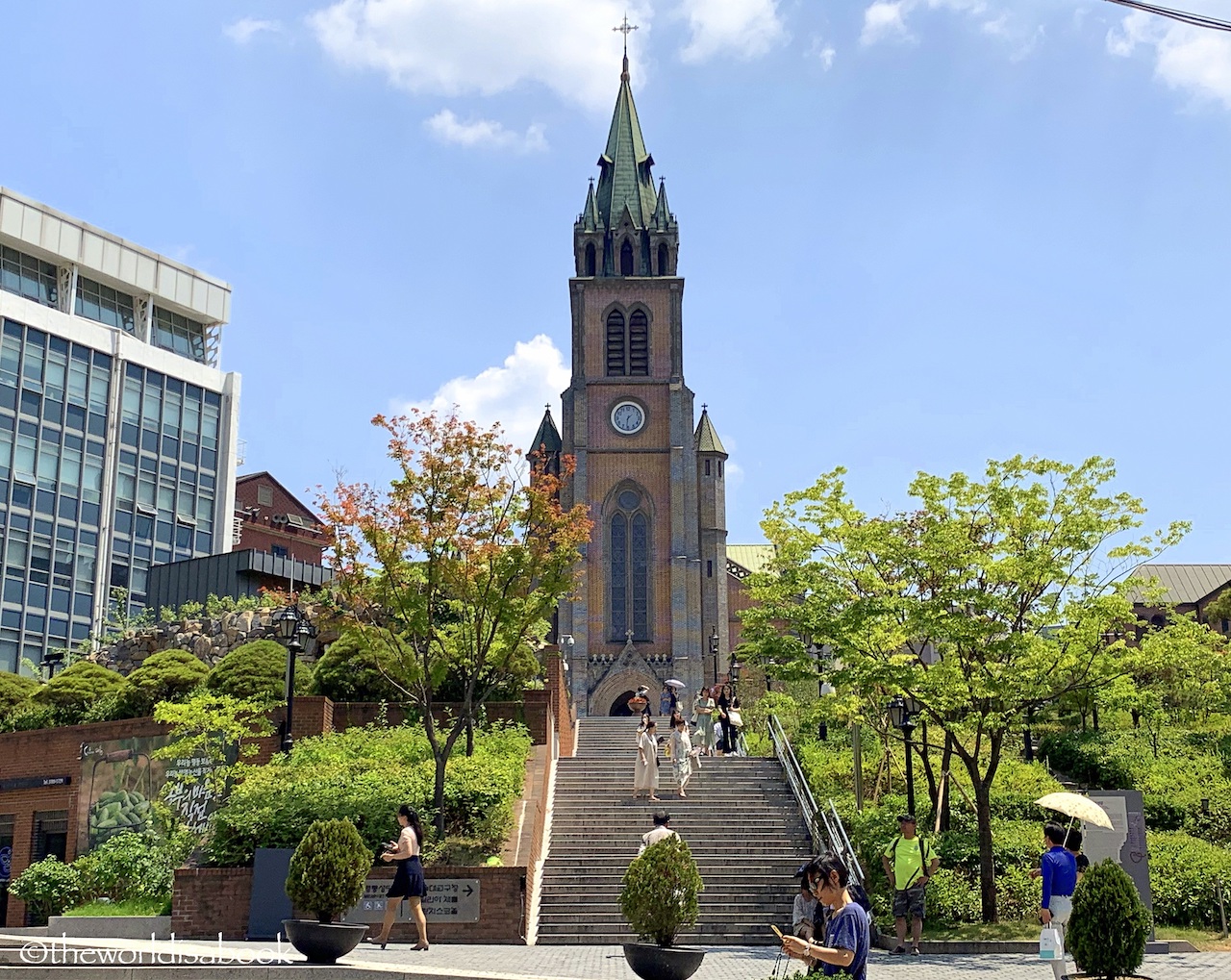
Its official name is the Cathedral Church of the Virgin Mary of the Immaculate Conception. It was Korea’s first Catholic church and continues to be one of the country’s most important churches.
We also found this LOVE sign sculpture by Robert Indiana across from the cathedral. Though, the popular ones in other cities were usually in red. We’re not sure if this was a temporary installation.
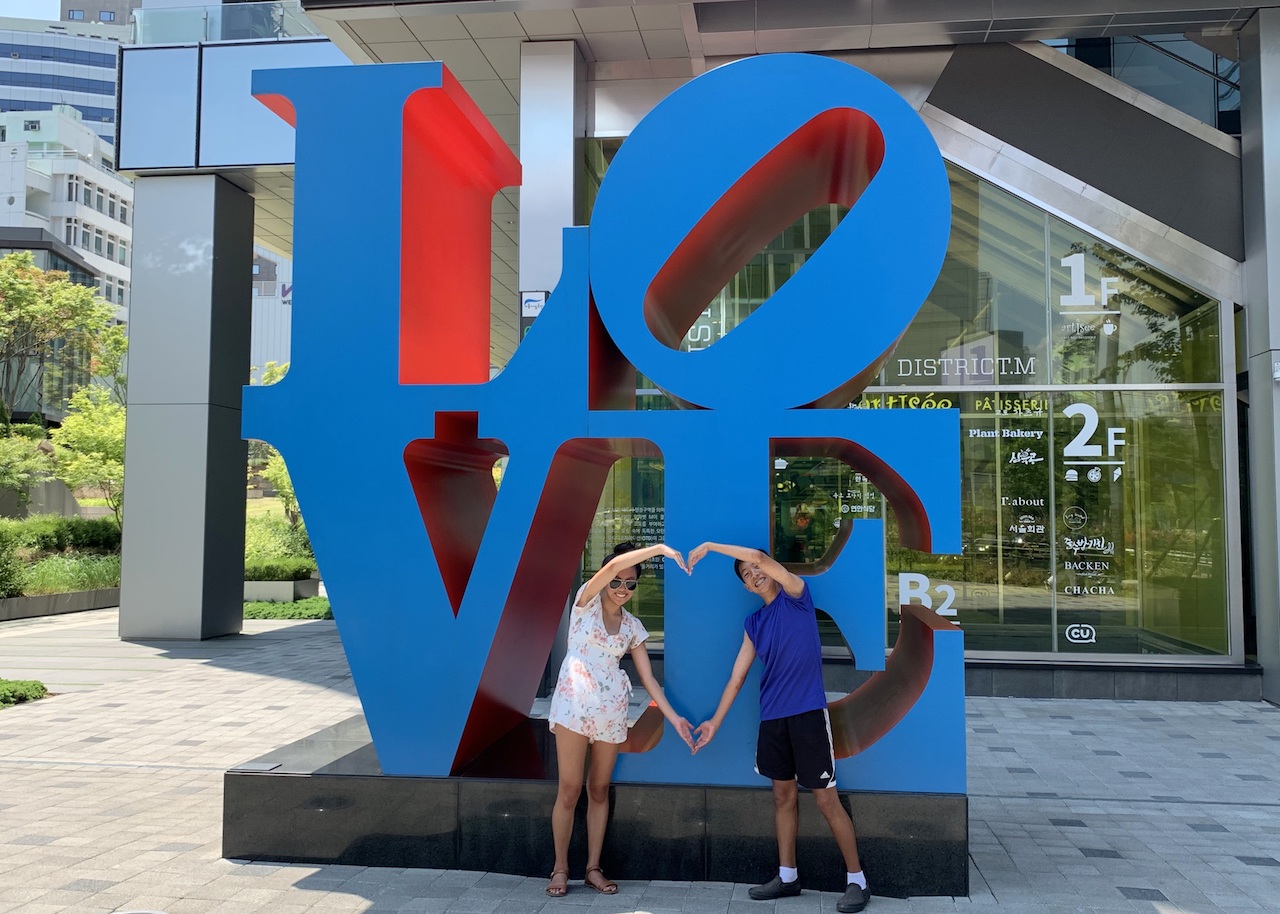
Shop The Myeongdong District
While we enjoyed strolling the Insadong district a week before, Myeongdong was much livelier and trendier with more stores and activities. We visites on a Saturday afternoon so there were many street food vendors. Everything we saw looked so delicious. Come hungry!
This district is a shopaholic and foodie paradise. My teen daughter loved walking around here with all the fashionable clothing and colorful cosmetics stores.
Many of the cosmetics stores gave out free samples for going in. We accumulated a collection of face masks walking around.
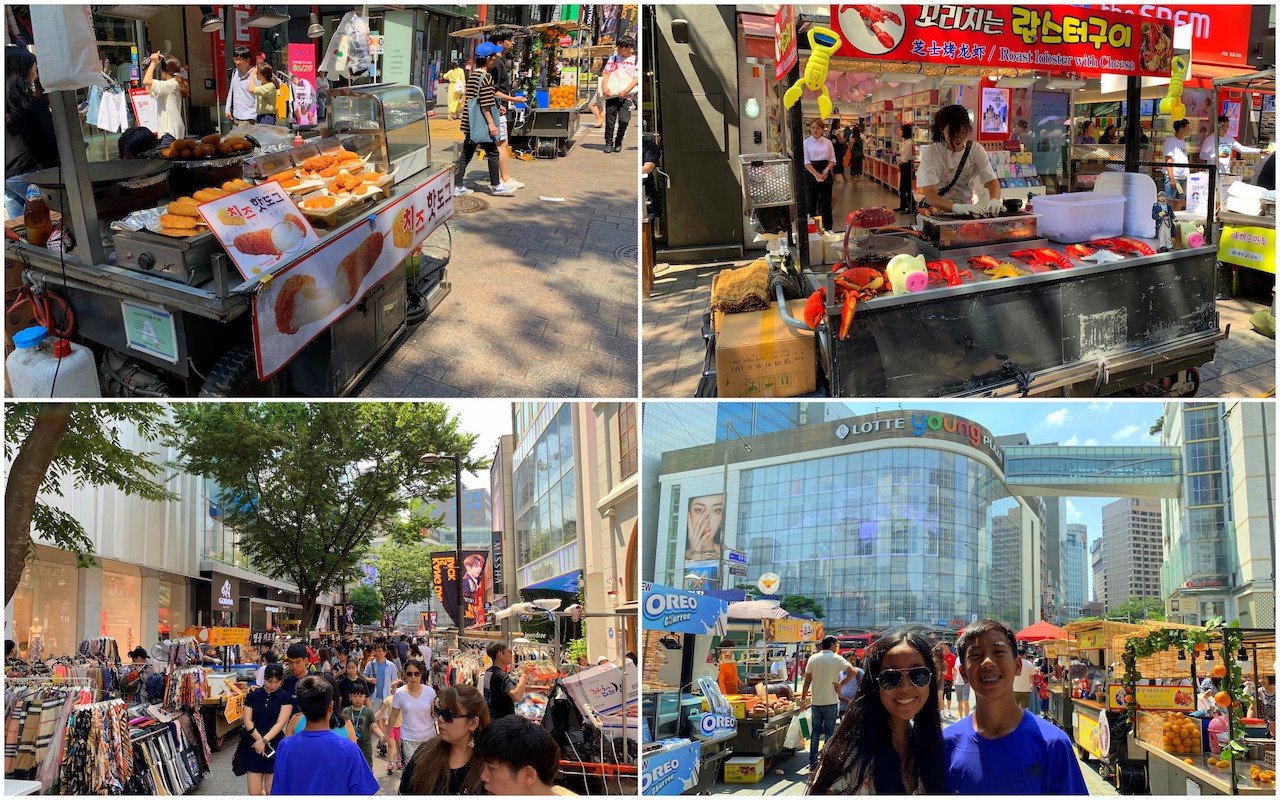
The World Is A Book contains affiliate links and is a member of the Amazon Services LLC Associates Program. If you make a purchase using one of these Amazon links or any of the product links, we may receive compensation at no extra cost to you. See our Disclosure Policy for more information.
Where to stay on your layover in Seoul
While there was a convenient transit hotel at the airport, it was a bit pricey and didn’t accommodate four people. So, we would have needed two rooms. Due to its convenient location, availability was also scarce.
The Hotel Queen Incheon Airport (click for the best hotel prices) offered rooms for transit passengers to use for the day between 8 to 11 hours between 6 AM to 6 PM. We had the room for 11 hours and it also provided a way to store our luggage while we went sightseeing and amenities to freshen up before and after our flights.
It was located about 10-15 minutes from the airport. They provided prompt shuttle pickups to and from the airport. The hotel rooms were huge and accommodated our family of four comfortably.
Their location was great and in a clean and safe area. Several restaurants, cafes and convenience stores surrounded the area and was a five-minute walk to the Unseo train station.
Tips for Spending a Long Layover in Seoul
- Wear comfortable walking shoes. Despite the great public transportation system, we still did a lot of walking. Seoul Station was huge and it took awhile to get from one subway line to another.
- Things to do at the airport. There’s a reason Incheon Airport (ICN) is consistently ranked among the best in the world. If you just want to pass some time at the airport and not see Seoul or its surrounding areas, there are plenty of things to do here as well.
The airport has plenty of shopping, nap rooms, free shower rooms (I used it and it was great), a movie theater, virtual reality and even an ice skating rink. There were also free cultural shows throughout the day.
- Do the airport led tours. The Incheon Airport Transit Tours is a wonderful program that really caters to visitors who are here for long layovers. They offer many tours depending on the visitors’ number of hours in Seoul. The tours range from the one-hour Temple tour or the one-hour Paradise City Art-Tainment tour to the four-hour Gwangmyeong Cave.
If the five-hour Gyeongbokgung Palace and Insa-dong tour looks a lot like our itinerary, it’s because we were inspired to follow it. But, we wanted to be flexible and add the Bukchon Hanok Village and spend more time at the other locations.
Reserve these tours in advance because some popular ones like the palace and shopping fill up fast. Most tours are free but some have a minimal fee to cover admission cost and lunch.
Shuttle buses take passengers to the designated tours along with a tour guide. There were also kiosks at the arrivals area to sign up. We saw plenty of signs at the airport for these transit tours and transit accommodations.
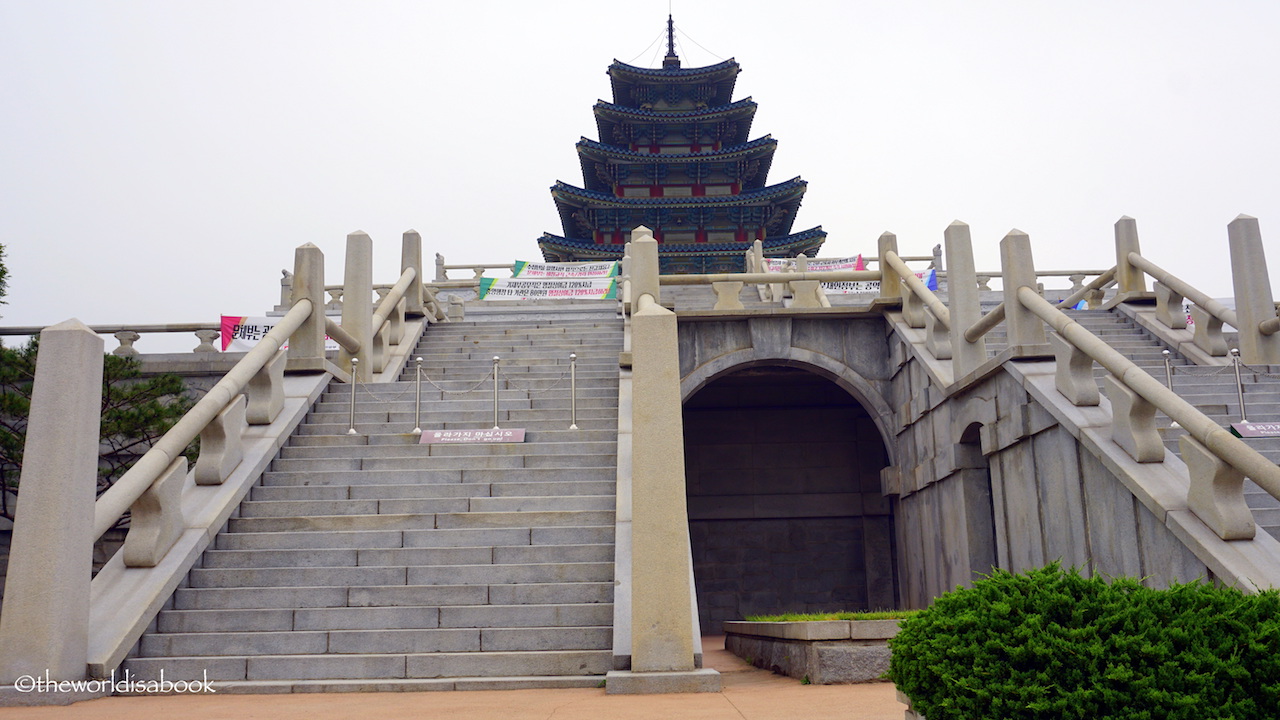
- Transportation Options from Incheon Airport to Seoul. The Seoul International Airport (ICN) is about an hour away from the city. There are various options to get out of the airport to explore the area if on a long layover. The taxis are the most expensive option so use as a last resort.
The AREX train is a great option. The Express non-stop train service between the airport and Seoul Station departs every 20 to 40 minutes and takes about 40 minutes.
There is also an All Stop Train which stops at multiple stations and leaves every 5-10 minutes and takes about an hour. Check this AREX website for the latest timetable and prices.
Many flights from the western USA seem to arrive around 4 or 5 AM at Seoul International Airport (ICN). Unfortunately, the direct trains into Seoul don’t start operating until 5:30 AM.
There are also several airport buses to various destination points in Seoul. Some of them will drop passengers right at the hotel’s front steps.
Travel time is about 60 to 80 minutes depending on traffic and location drop-off. We saw some of the bus ticket booths at the arrivals area and these were operating before 5:30 AM. Check out these three companies: Seoul Airbus, KAL Limousine Bus
- Do the Hop On Hop off tour. Like many major cities, the Hop On Hop Off (HOHO) tour buses offer a great orientation. We found some of them in Seoul but didn’t have enough time to take advantage of it. We’ll definitely do one on our return visit. This HOHO is another way to spend a long layover.
The Seoul hop-on, hop-off bus tour has three routes and stops at many of Seoul’s popular attractions. Visitors can board the bus at any of the designated stops. There is an English speaking guide onboard plus audio guides in 12 languages. The buses run everyday except Monday. 1-day or 2-day tickets are available.
- Get the Go City Card (click for the best prices and save up to 50% on Seoul attractions). This pass will save you money when visiting several attractions in Seoul.
*Have you visited Seoul? Favorite Layovers?
Pin it for later!
